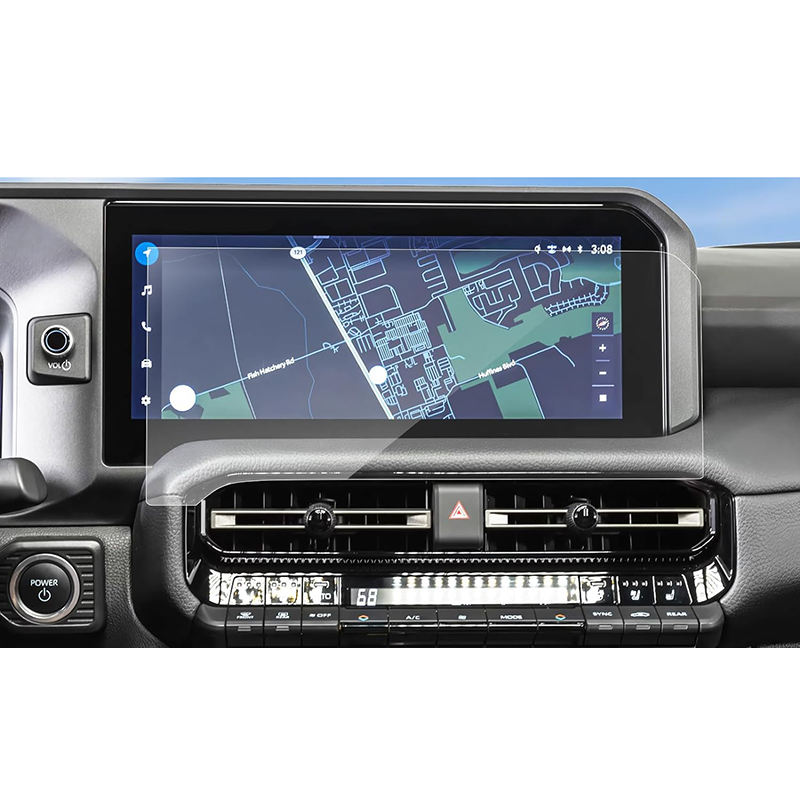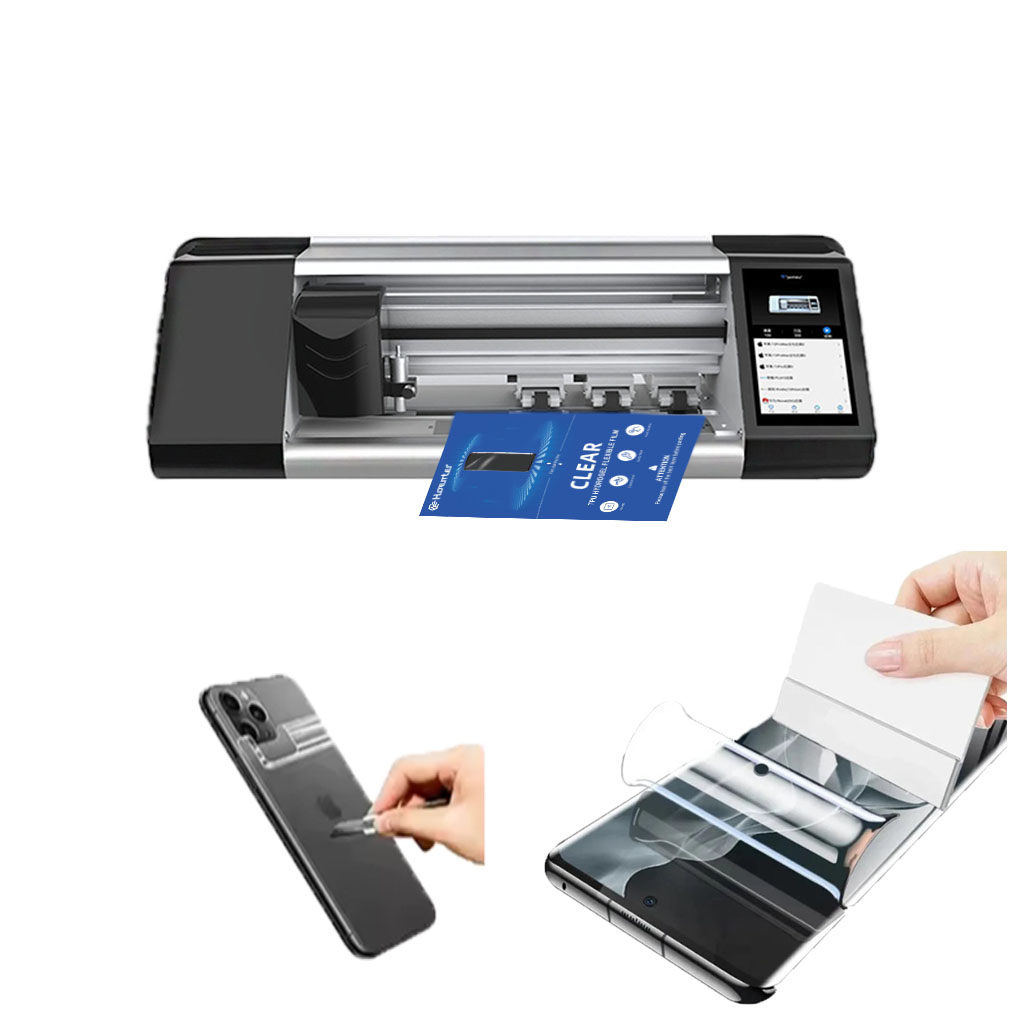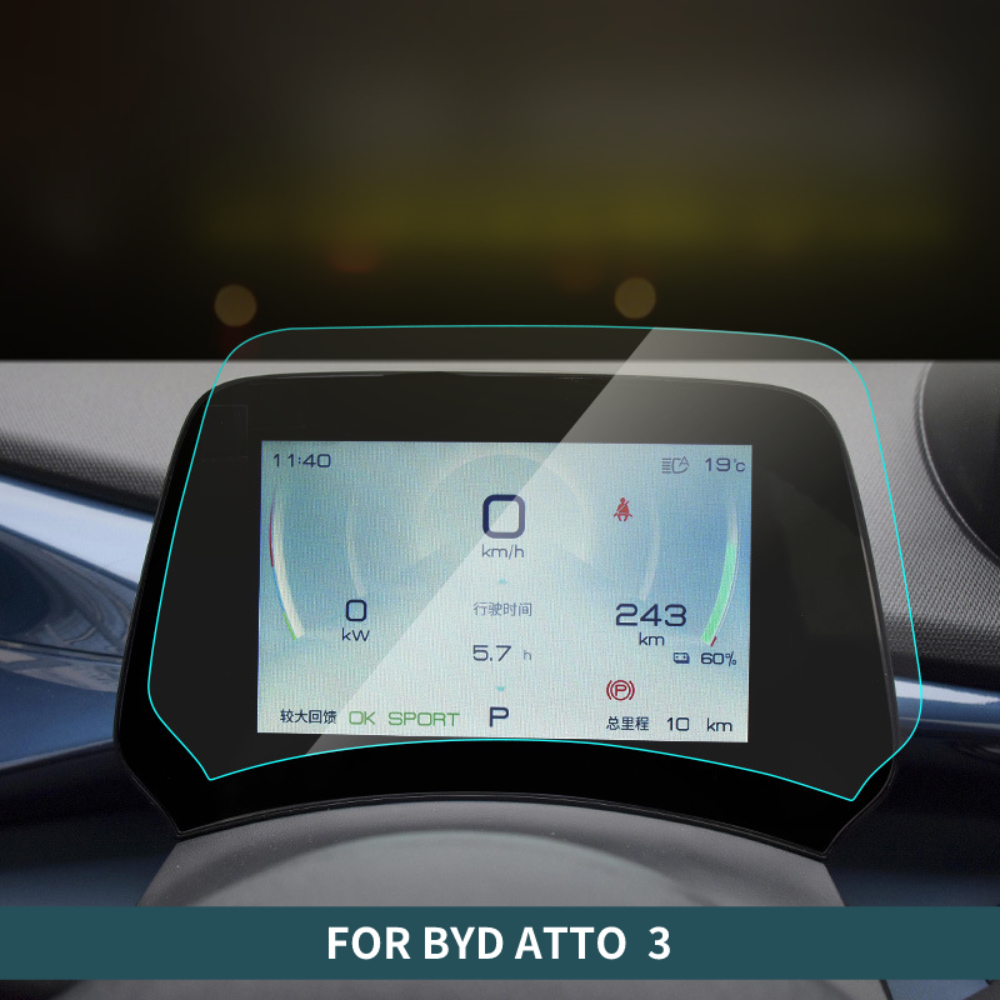
What's A Screen Protector Cutting Machine?
Table of Contents
Summary
Leveraging advanced cutting technologies such as laser and blade cutting, these machines offer precision and efficiency, making them essential tools for both personal and commercial use. The development of screen protector cutting machines is rooted in the evolution of vinyl cutting technology, which has seen significant advancements since the mid-20th century. From the early vinyl cutters of the 1960s to the sophisticated laser cutters of today, these machines have continually adapted to meet the changing demands of the industry. The primary types of screen protector cutting machines include physical cutting machines and laser cutting machines. Physical cutting machines use blades to cut screen protectors, offering an environmentally friendly and safe option for use in various settings. Laser cutting machines, while highly precise, can produce gases and pollutants, which may limit their usage in certain environments. Multi-functional cutting machines, such as the Cricut Explore 3, combine various cutting technologies and are capable of handling a wide range of materials, enhancing their versatility and functionality. Screen protector cutting machines are equipped with a variety of advanced features, including smart material compatibility, design software integration, wireless capabilities, and perf cutting. These features ensure precise cuts, enhance the user experience, and improve overall efficiency. Modern machines also incorporate sleek and durable designs, making them visually appealing and reliable for long-term use. Despite their many advantages, there are some limitations, such as the prevalence of marketing language, challenges with creating precise designs for varied device sizes, and inventory management concerns.
The market for screen protector cutting machines is expanding rapidly, driven by increasing consumer demand for customized screen protection solutions. Prominent manufacturers like Teneth Technology Co., Ltd., WillDone, and the MTB-CUT series are leading the industry with innovative products and comprehensive services. These companies offer machines that cater to diverse needs, from small personal projects to large-scale commercial production. The future of screen protector cutting machines looks promising, with ongoing advancements in cutting technologies, materials, and environmental sustainability set to further enhance their capabilities and market appeal.
History of Screen Protector Cutting Machine
The evolution of screen protector cutting machines is deeply intertwined with advancements in vinyl cutting technology, which has seen significant progress since the mid-20th century. During the early 1960s, the market for decorative films, particularly wood-grain replicas, experienced a surge. Technicians developed techniques to etch wood-grain features from real wood veneers onto print rolls, making these films more realistic. By 1966, the major American automakers—American Motors, Chrysler, Ford, and General Motors—had adopted wood-grain films for various vehicle models. In 1956, pressure-sensitive vinyl film was introduced, a significant advancement that, coupled with more color options, increased vinyl usage in signs and emblems. This period also saw the development of an easy-to-peel silicone release liner, which has remained a staple for protecting vinyl film’s adhesive backing. The introduction of translucent films in 1983 marked another milestone, allowing technicians to cast wide-format films with uniform backlit color for the first time. This technology provided a more uniform image compared to previous methods like spray painting and screen printing. Vinyl cutting plotters, which later evolved to become essential in the production of screen protectors, began as early pen plotters in 1959. These early machines moved paper over a roller for X motion while the pen moved on a track for Y motion. Vinyl cutters are primarily used to produce single-color line art and lettering. However, advancements in digital, electronic vinyl-film cutters revolutionized the sign industry, significantly boosting production speeds and reducing costs, which in turn increased demand for vinyl. The adoption of large-format inkjet printers, which print directly onto various materials using solvent-based inks, further reduced the reliance on cutting plotters for applications like billboard design. However, precision contour-cutting of graphics produced by these printers remains a critical function of cutting plotters, especially for vehicle wraps and shaped stickers. In 1965, the introduction of graphic films featuring microscopic glass bubbles in the adhesive allowed for repositioning before final adhesion, greatly expanding the market for these films. The continuous improvement of vinyl films, adhesives, and inks over the decades has driven the evolution of screen protector cutting machines, ensuring they meet the ever-changing needs of the industry. Today, screen protector cutting machines benefit from these historical advancements in vinyl cutting technology, allowing for precise and efficient production of screen protectors tailored to a variety of devices.
Types of Screen Protector Cutting Machines
Screen protector cutting machines can be categorized based on their cutting mechanisms, material compatibility, and additional features. The two primary types of cutting mechanisms are physical cutting and laser cutting, each with distinct advantages and disadvantages.
Physical Cutting Machines
Physical cutting machines utilize a blade to cut screen protectors, which offers several benefits. Unlike laser cutting machines, they do not produce unpleasant gases or pollutants, making them safer and more environmentally friendly for use in various settings such as shopping malls and homes. These machines are often designed with adjustable cutting pressure and speed, enabling them to handle materials from different companies. Physical cutting machines come equipped with features like double motors for strong cutting power, a 6-inch HD screen for easy operation, and a self-developed cloud system for timely data updates. Some models also offer back film pattern customization, allowing users to print their own designs. These machines are generally suited for cutting flexible screen protector materials such as TPU and PET, but they are not ideal for cutting glass screen protectors.
Material Compatibility
Physical cutting machines can work with a variety of materials including HD clear, matte, privacy, and anti-blu-ray screen protectors. This versatility ensures that users can choose the most suitable material based on their specific needs and preferences.
Laser Cutting Machines
Laser cutting machines, on the other hand, use laser technology to cut materials. While they are highly precise and capable of intricate cuts, they can produce unpleasant gases and pollutants, which may limit their usage in certain environments. Laser cutting machines are typically more expensive and may require additional safety measures due to the potential hazards associated with laser technology.
Multi-Functional Cutting Machines
Some advanced cutting machines, like the Cricut Explore 3, offer multi-functional capabilities. These machines can cut over 100 different materials, including popular ones like vinyl, iron-on, and cardstock, without the need for a cutting mat. They are compatible with various tools and accessories such as the Deep-Point Blade and Foil-Transfer Tool, enhancing their functionality. Additionally, these machines often feature wireless connectivity and software compatibility with programs like Adobe Illustrator and CorelDRAW, making them versatile for both personal and professional use.
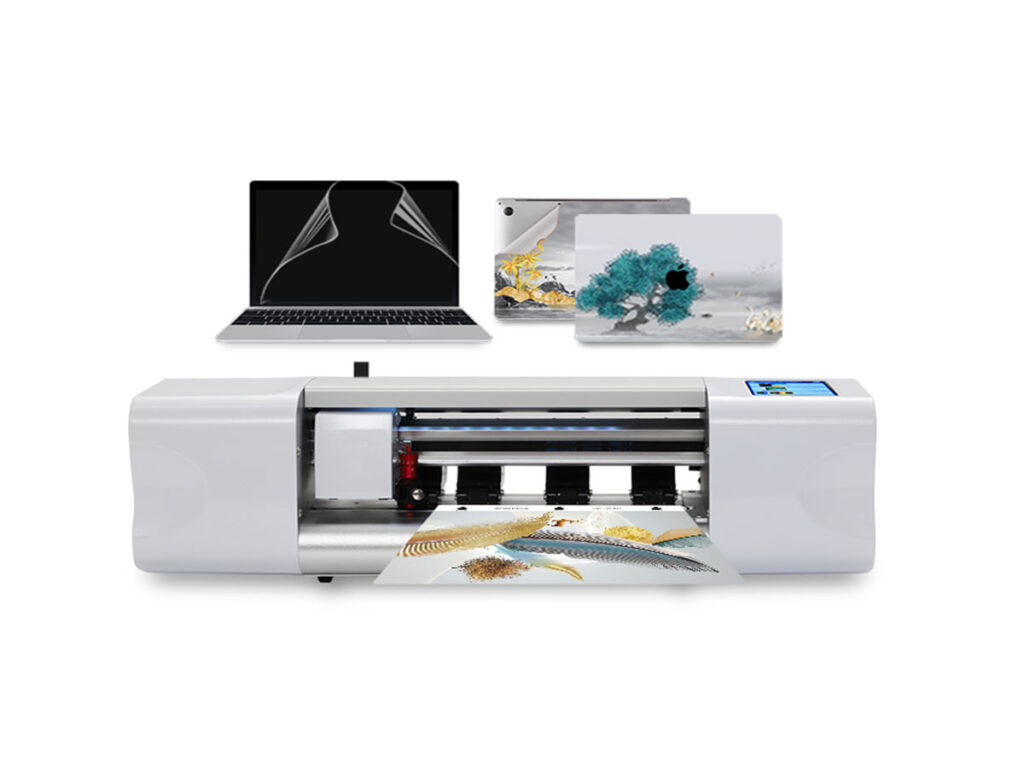
Components and Features
Screen protector cutting machines are versatile tools designed to handle a variety of materials, including vinyl, leather, fabric, and balsa wood. These machines are equipped with an array of features and components that make them highly efficient and adaptable to numerous crafting and industrial applications.
Cutting Mechanism
The primary function of these machines is to cut precise outlines of figures into various materials without penetrating the backing material. This is achieved through a small knife or blade that moves side to side and rotates, while the material is moved beneath it. The design is then ‘weeded,’ where excess material is removed, leaving the desired image on the backing material.
Smart Material Compatibility
Integrated with advanced design software, screen protector cutting machines offer limitless creative possibilities. Users can choose from pre-made designs or create custom projects, making the crafting process more engaging and boundless[ translating operator commands into precise movements while monitoring the machine’s status to ensure safe operation. Software components provide an intuitive user interface for inputting cutting parameters and creating complex cutting patterns, maximizing the machine’s versatility and efficiency.
Sleek and Durable Design
Not only are these machines performance powerhouses, but they also boast sleek designs that enhance the aesthetic appeal of any crafting space. Built to last, they combine functionality with visual appeal, making them a prized possession for both hobbyists and professionals.
Wireless Capabilities
Modern screen protector cutting machines come equipped with wireless capabilities, allowing users to send their designs from a device without being tethered to the machine. This feature adds a layer of convenience and flexibility, facilitating smoother and more efficient workflows.
Tracking and Media Handling
Tracking capabilities are crucial for the efficient production of medium to long graphics, such as banners and vehicle wraps. High-quality pinch roller assemblies and advanced control panel features contribute to superior tracking. Digital servo motors further enhance tracking accuracy, making them ideal for projects that require long cutting lengths.
Perf Cutting
Advanced cutters feature perf cutting capabilities, allowing them to perform both traditional “kiss cuts” and complete cuts through all layers of material without damaging the platen. This feature is especially beneficial for producing pop-out decals and is found in high-end models like the Vinyl EXPRESS Q Series and Graphtec FC-9000 machines.
Screen Specifications
The screen is often the most frequently replaced component in a cutting machine. Screens can be manufactured with sharp or rounded edges, affecting performance and particle flow. Slotted, herringbone, and conidur screens each offer unique benefits, such as enhanced cutting action, reduced skipping, and suitability for various product types. The hole size of the screen is also critical, chosen based on the
mill’s capability and the material’s friability. By integrating these features, screen protector cutting machines offer unparalleled precision, efficiency, and versatility, making them indispensable tools in both crafting and industrial settings.
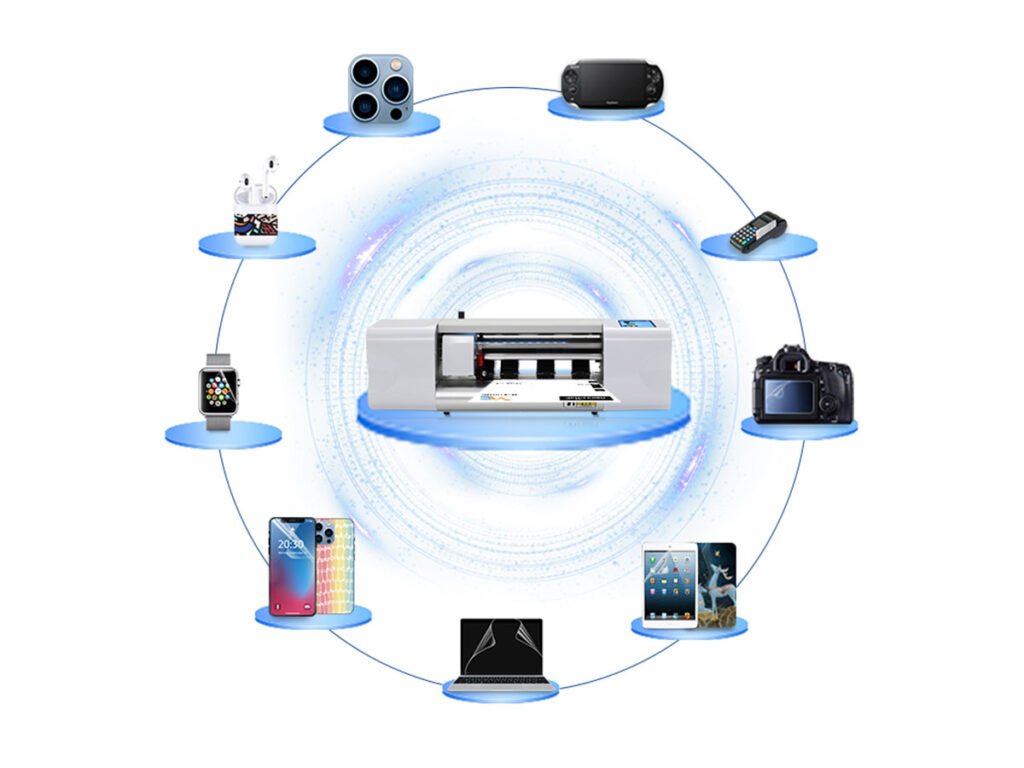
Cutting Technologies
Screen protector cutting machines utilize a variety of cutting technologies to achieve precise and efficient cuts. These technologies are crucial for meeting the diverse needs of different materials and ensuring high-quality production. The main types of cutting technologies used in these machines are blade cutting and laser cutting.
Laser Cutting
Laser cutting is a more modern and advanced technology that has revolutionized the cutting industry. Initially developed in the 1960s, laser cutting has undergone significant advancements, making it more accessible and efficient. Unlike traditional techniques that require frequent mold replacements, laser cutting can adapt to changes in device sizes and shapes without costly retooling, providing improved
efficiency and cost-effectiveness. This technology allows manufacturers to keep up with rapid technological advancements and deliver screen protectors for the latest devices. Laser cutting machines, such as those by WillDone, are equipped with high-speed laser systems that ensure efficient production without compromising quality. This method is not only precise but also significantly faster compared to manual cutting or die-cutting, reducing production time and meeting increasing demand promptly. Laser cutting’s non-contact process minimizes wear on cutting tools and reduces material waste, aligning with modern sustainability goals.
Blade Cutting
Blade cutting is a traditional yet highly effective method used in many screen protector cutting machines. The technology works by employing a fine-point blade to perform intricate cuts on various popular materials, including vinyl decals and iron-on transfers. Advanced blade cutting machines like the Cricut Explore 3 can cut over 100 different materials, including smart materials, without needing a cutting mat. This allows for cuts as long as 12 ft (3.6m) at once, enhancing productivity and versatility. Additionally, blade cutting machines offer adjustable cutting pressure and speed, enabling users to cut materials from different companies on the same machine. These machines often come with advanced features such as built-in screens for easy operation and cloud systems for timely data updates. This technology is particularly beneficial for producing intricate decals and other detailed designs, as seen with machines like the Vinyl EXPRESS Q Series and Graphtec FC-9000, which offer “pop-out” decals through a two-step perf cutting process.
Materials
Supported materials for screen protector cutting machines are diverse and cater to a wide range of applications. These machines can handle cast and calendared vinyl, reflective films, heat transfer films, and various stencil films. For effective cutting, the choice of blade depends on the media’s texture. A 60-degree blade is recommended for raised textures, while a 45 or 30-degree blade suffices for smooth vinyl. In addition to the different types of vinyl, adhesive vinyl comes in a variety of colors and materials, including gold and silver foil, vinyl that simulates frosted glass, holographic vinyl, reflective vinyl, thermal transfer material, and even clear vinyl embedded with gold leaf . These materials can be used for various applications like store windows, car decals, and signage. The hydrogel film cutting machine is specifically tailored to create screen protectors and rear films for mobile phones, tablets, e-books, and other electronic products. This machine includes more than 26,000 data points for cutting various device models, including smartphones and tablets. It also features a hydrogel film that offers flexibility and slightly better impact absorption, making it suitable for curved screen users. For screen protector cutting machines, some general bundles include vinyl cutting blades, magnetic blanks and sheets, vinyl in various colors, hobby knives, and squeegees. The machines can cut card stock, paint mask, standard and heat transfer vinyl, paper, and craft paper, but are not suitable for tint, low and high intensity reflective materials, sandblast resist, and unlined media.
Operation
Operating a screen protector cutting machine involves several steps and considerations to ensure the production of high-quality protectors that meet specific requirements. The process can be streamlined with advanced features and technologies integrated into the machines.
Initial Setup
Before starting the cutting process, it is essential to set up the machine properly. For instance, the Cricut Maker 3 is equipped with a docking slot and a USB port for charging devices while you work. This machine also supports a variety of Smart Materials, which do not require a mat for cutting, thereby simplifying the setup process. Users can easily create personalized and custom designs using the cloud-based Design Space app compatible with iOS, Android, Windows, and Mac devices.
Cutting Process
For the cutting process to commence, materials need to be loaded into the machine. Advanced cutters like the Vinyl EXPRESS Q Series and Graphtec FC9000 are capable of performing perf cutting, which involves a two-step process: a “kiss cut” that cuts only through the face film, followed by cutting through the face film, adhesive, and liner without damaging the platen. This feature is crucial for producing pop-out decals and other intricate designs.
The choice of the sizing screen plays a pivotal role in the efficiency and quality of the size reduction process. Screens with a sharp or burred edge facing the flow of particles enhance cutting action and expedite material exit. Conversely, screens with rounded edges can cause more residence time and reduced capacity
Customization and Adjustments
The machines offer various customization options to cater to different cutting needs.rs can make their own screen protectors by entering parameters such as length, width, and diameter into the machine’s custom function. However, for more complex templates, special software and professional technicians may be required to convert designs into supported file formats.
Performance Optimization
To maintain and optimize performance, it is important to regularly assess and replace the sizing screens. Considerations should include the screen’s lifespan, failure points, and whether the particle size objectives are being met. Additionally, selecting the appropriate gauge for the screen—where a higher gauge number indicates a thinner screen—is vital for balancing capacity and durability.
Post-Cutting Steps
After the cutting process, the next steps involve quality assurance and any necessary adjustments. Professional technicians provide staff training and technical advisory services, ensuring smooth operation and troubleshooting of any issues. The ma- chines often come with built-in storage to keep the working surface organized, and features like Bluetooth control for effortless operation via mobile devices.
Applications
Screen protector cutting machines have versatile applications across a range of devices, including smartphones, tablets, smartwatches, laptops, and monitors. These machines offer a tailored solution for protecting screens from scratches, minor impacts, and everyday wear.
Smartphones
Smartphones are among the most frequently used devices, making them highly susceptible to screen damage. Screen protector cutting machines are ideal for crafting protectors that fit various smartphone models, offering a customized shield that preserves the display quality and enhances durability. With the added benefit of antibacterial properties, some protectors can also reduce the growth of germs on the screen surface.
Tablets
The larger screens of tablets benefit greatly from the precise cutting capabilities of these machines. By providing a snug fit, screen protectors ensure that users enjoy an enhanced viewing experience without compromising on the tactile feel of the touchscreen. Machines like the Cricut Explore Air and the Brother ScanNCut DX offer cutting capabilities for thicker materials like leather and vinyl, which can also be applied to screen protector production for tablets.
Smartwatches
The compact and often curved screens of smartwatches pose unique challenges for screen protection. Screen protector cutting machines can address these challenges by creating protectors that conform precisely to the watch face, safeguarding it against scratches and scuffs while maintaining full functionality. Machines equipped with advanced features such as dual blade modes and laser cutting, like the xTool M1, provide the precision needed for these intricate designs
Laptops and Monitors
For larger screens such as those found on laptops and desktop monitors, screen protector cutting machines offer an effective solution to prevent scratches and smudges.The use of advanced materials like nano glass and graphene ensures unparalleled strength and scratch resistance, thereby extending the lifespan of these devices. Machines like the Brother CM350E, with its versatile material compatibility, are particularly useful for creating durable and clear screen protectors for larger screens. Screen protector cutting machines have thus proven to be indispensable tools in the realm of device protection, offering custom-fit solutions that cater to a wide variety of electronic devices.
Advantages
Screen protector cutting machines offer a multitude of advantages, making them indispensable in various industries and applications. One of the most significant benefits is the precision they bring to the manufacturing process. Traditional cutting methods often result in inconsistent shapes and imperfect fits, but the advanced technology of laser cutting machines ensures accurate and seamless cutting of
screen protectors, leading to a flawless end product. Another advantage is the quiet operation of machines driven by digital servo motors.
These motors use digital encoders to translate software commands into precise movements, allowing the cutter to turn and pivot along smaller paths with exceptional accuracy. This is particularly beneficial for cutting intricate designs and small characters, which would be challenging with stepper-driven cutters. The versatility of these machines cannot be overstated. Many screen protector cutting machines are capable of handling various materials such as vinyl, leather, fabric, and even balsa wood. This versatility is enhanced by smart material compatibility features that automatically detect and adjust settings based on the material being used, eliminating guesswork and ensuring perfect cuts every time. Moreover, the spooling function in some cutters allows users to send multiple jobs into the queue at once, similar to how a printer operates. This feature is particularly useful for creating multi-layered projects without the need to switch between rolls,
thereby increasing efficiency and productivity
Disadvantages
While screen protector cutting machines offer a range of benefits, they also come with several disadvantages that potential users should consider.
Limited to Marketing Language
One common issue is the prevalence of marketing language that can be misleading. Many features touted by manufacturers, such as “high transparency” or “ultra-clear” coatings, are often just marketing jargon designed to sell products. These terms do not necessarily indicate a superior product, as every screen protector will impact visibility to some degree.
Lack of Precise and Intricate Designs
Traditional screen protector production techniques struggle with creating precise and intricate designs due to the fixed shape of molds. This limitation becomes problematic when dealing with the varied sizes and dimensions of modern electronic devices. As a result, these techniques fail to provide the perfect fit and complete coverage that consumers expect.
Inventory and Stock Management
Despite some claims to the contrary, managing inventory and stock can still be a concern. Although the screen protector cutting machine allows for on-demand production, alleviating some inventory pressures, other logistical issues such as freight costs can be significant. The COVID-19 pandemic has exacerbated this issue, with skyrocketing freight costs adding to the overall expense. For shipments where the postage exceeds a certain threshold, additional costs are incurred, making inventory management more complicated
Potential for Device Damage
No screen protector is impervious to damage from drops, dings, or scratches. Even with a cutting machine that offers high precision, the protector itself cannot guarantee full protection against significant impacts. Consumers should not rely solely on screen protectors and are advised to consider additional protective measures such as cases, especially for larger devices like tablets and the iPhone Pro Max. By being aware of these limitations, users can make more informed decisions and better manage their expectations when investing in a screen protector cutting machine.
Market and Manufacturers
The market for screen protector cutting machines has expanded significantly in recent years, driven by increasing consumer demand for customized and precise screen protection solutions for various electronic devices. The industry includes several notable manufacturers who offer innovative products and comprehensive services to cater to a diverse clientele.
Teneth Technology Co., Ltd.
Shenzhen Teneth Technology Co., Ltd. is a prominent manufacturer in the cutting industry, specializing in sign-making products such as vinyl cutters, screen protector film cutters, and label cutters. Established in 2012, Teneth has approximately 10 years of experience in the field and has gained recognition for its advanced technology and high-quality products. The company’s headquarters is located in Shenzhen, China, with over 100 employees. Teneth’s products are distributed to over 100 countries, including the United States, Germany, France, and Brazil. The company offers both complete cutting machines and individual components, ensuring a total solution for its customers’ cutting needs. Teneth’s commitment to high standards and competitive pricing has earned it a strong reputation and attracted numerous OEM and ODM projects from transnational corporations.
WillDone
Another key player in the market is the WillDone brand, known for its laser cutting machines designed specifically for screen protector production. WillDone has become synonymous with innovation and precision, pushing the boundaries of what is possible in this field. Their cutting-edge technology allows for intricate and complex designs with unparalleled precision, crucial for the production of high-quality screen protectors. The precision and accuracy offered by WillDone’s laser cutting machines set them apart from traditional cutting methods, making them a trusted partner for numerous manufacturers in the industry.
MTB-CUT Series
The MTB-CUT series, including models like the MTB-CUT 180A, MTB-CUT 180AL, and MTB-CUT M188, offers various options for cutting screen protectors of different sizes. These machines are known for their high-precision cutting knives, adjustable scales, and cutting pressures that meet the requirements of various materials. The MTB-CUT 180A can cut screen protectors up to 11 inches, while the MTB-CUT 180AL supports sizes up to 16 inches, catering to larger devices such as laptops. These machines also support mobile app connectivity, allowing users to control the machine via a smartphone, and offer the ability to cut custom designs by connecting to a computer. The MTB-CUT series provides a comprehensive solution for businesses, from machines to functional cutting materials, making it easy for newcomers to expand their business quickly.
Distribution Channels and Eco-Conscious Initiatives
Screen protectors and cutting machines are distributed through various retail channels, including online marketplaces, electronics stores, and specialized accessory retailers. Many manufacturers also sell directly to consumers through their websites, fostering closer relationships and offering personalized support. Some manufacturers are also embracing environmentally conscious initiatives, such as using sustainable packaging materials and exploring carbon-neutral shipping options to reduce the environmental impact of their products.
Future Prospects
The future of screen protector cutting machines is incredibly promising, characterized by rapid advancements and increasing capabilities that continue to reshape the industry. One of the primary drivers of this evolution is the integration of cutting-edge technology such as laser cutting machines. Companies like WillDone are at the forefront, pushing the boundaries to provide manufacturers with state-of-the-art machines that guarantee exceptional results and revolutionize production processes.
Scalability and Innovation
The scalability of modern laser cutting machines is paramount as manufacturers aim to meet rising demands. These machines seamlessly integrate into production lines, allowing for efficient scaling of operations. Additionally, the innovative capabilities of these devices open new avenues for product development, enabling the creation of creative and customized screen protector designs.
Advancements in Materials
Another exciting prospect in the realm of screen protector cutting machines is the advent of new materials. Traditional plastic films are being replaced by advanced materials such as nano glass, graphene, and self-healing polymers. These materials offer unparalleled strength, scratch resistance, and overall durability. The development of these cutting-edge materials is largely driven by advancements in nanotechnology, which allows for nanoscale manipulation to create ultra-thin, transparent protectors that safeguard screens more effectively.
Enhancing Efficiency
Efficiency is a critical aspect of modern screen protector production. The latest laser cutting machines significantly enhance production efficiency, enabling manufacturers to produce high-quality protectors rapidly and with minimal error. This is crucial in a market where speed and precision are vital to maintaining a competitive edge.
Environmental Improvements
The future also promises significant environmental improvements in the production of screen protectors. Recent developments include the use of lead-free inks and heavy-metal-free UV piezo inks, which offer both flexibility and durability. Scientists are continuously exploring ways to eliminate harmful substances from graphic films without sacrificing performance, thereby contributing to more sustainable manufacturing practices.
Comments
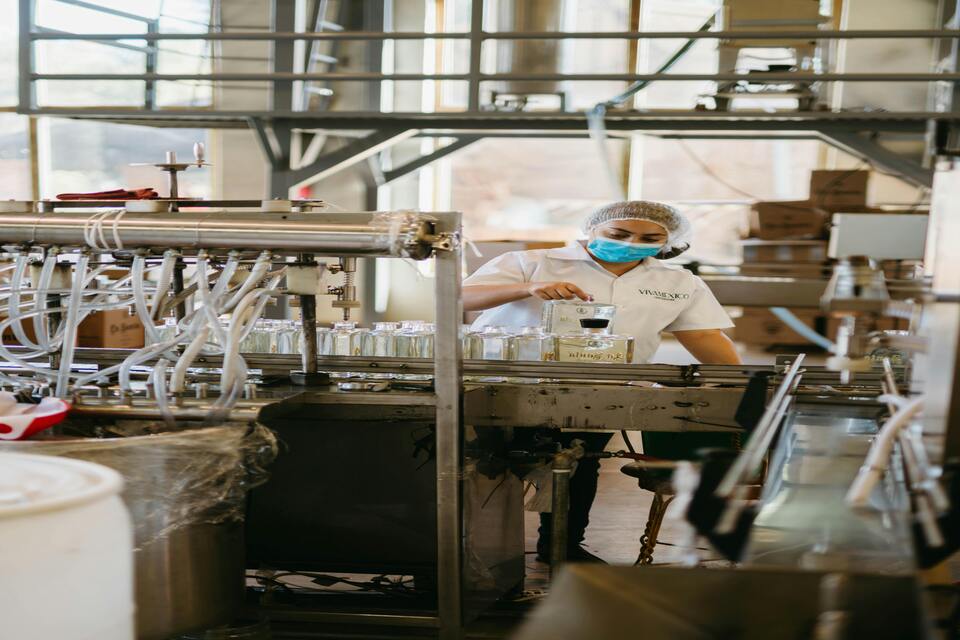
Where Can I Repair My Phone Screen?
By understanding your options and the intricacies of phone screen repair, you can make informed decisions that keep your device in top condition.

2014-2019 Infiniti Q50 Navigation Tempered Glass
Get the best Infiniti Q50 InTouch Screen Protectors.Scratch-resistant tempered glass designed to maintain the touch sensitivity of your dual displays.

How Much Is Phone Screen Repair?
Understanding these aspects can help you make informed decisions about phone screen repairs, ensuring you get the best value for your money.

How to Remove Invisible Shield Screen Protector?
By following these steps, you can confidently remove and replace your Zagg InvisibleShield screen protector, ensuring your device stays protected and looking its best!

How Much to Repair Phone Screen?
By following these guidelines, you can navigate the complexities of phone screen repairs with confidence, ensuring your device continues to serve you well.
Tags
Find All knowledge and trends from our blog, get the wholesale price and best quality from our factory.

What Film Cutting Machine and Its Application
Film cutting machines have played a crucial role in the evolution of filmmaking and various industrial processes by enabling precise cutting and splicing of film materials.

What Is a Screen Protector Cutting Machine?
A screen protector cutting machine is a specialized device designed to produce custom-fit screen protectors for various electronic devices, including smartphones, tablets, smartwatches, laptops, and monitors.

How Mobile Phone Screen Protector Cutting Machine Work?
A mobile phone screen protector cutting machine is a sophisticated device designed
to produce customized screen protectors for various digital devices with high preci
sion and efficiency.

Characteristics of Mobile Phone Tempered Glass and Mobile Phone TPU Screen Protector
Thermoplastic polyurethane (TPU) screen protectors are flexible, durable, and
self-healing plastic films designed to protect electronic device screens from
scratches, impacts, and other potential damages.

Revolutionize Device Protection with Screen Guard Cutting Machine
Whether you possess a smartphone, tablet, or smartwatch, this versatile machine accommodates a vast array of devices. It seamlessly adapts to the dimensions of your gadget, offering a custom fit that generic protectors can’t match.

Screen Protector Lifetime Warranty
A screen protector lifetime warranty is a guarantee provided by manufacturers that
promises to repair or replace a screen protector for the lifetime of the product, under specific terms and conditions.


